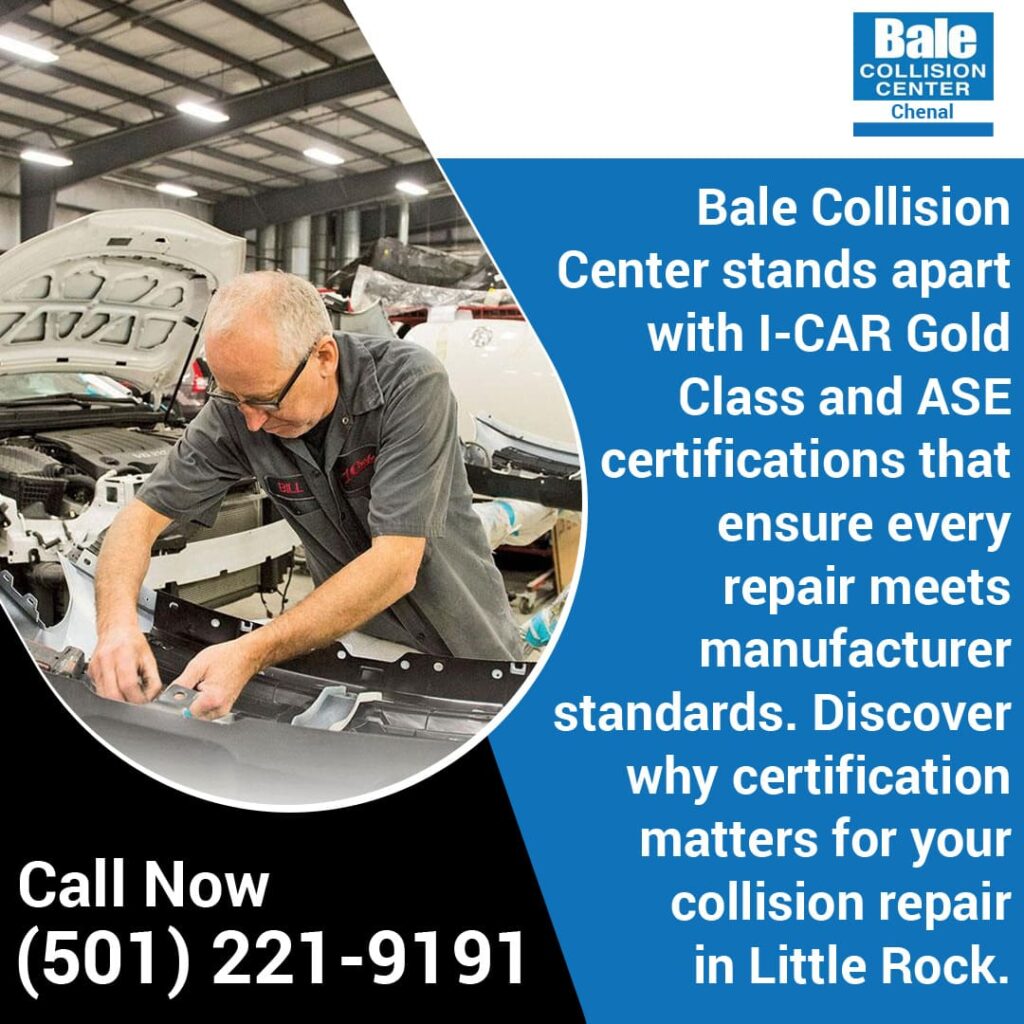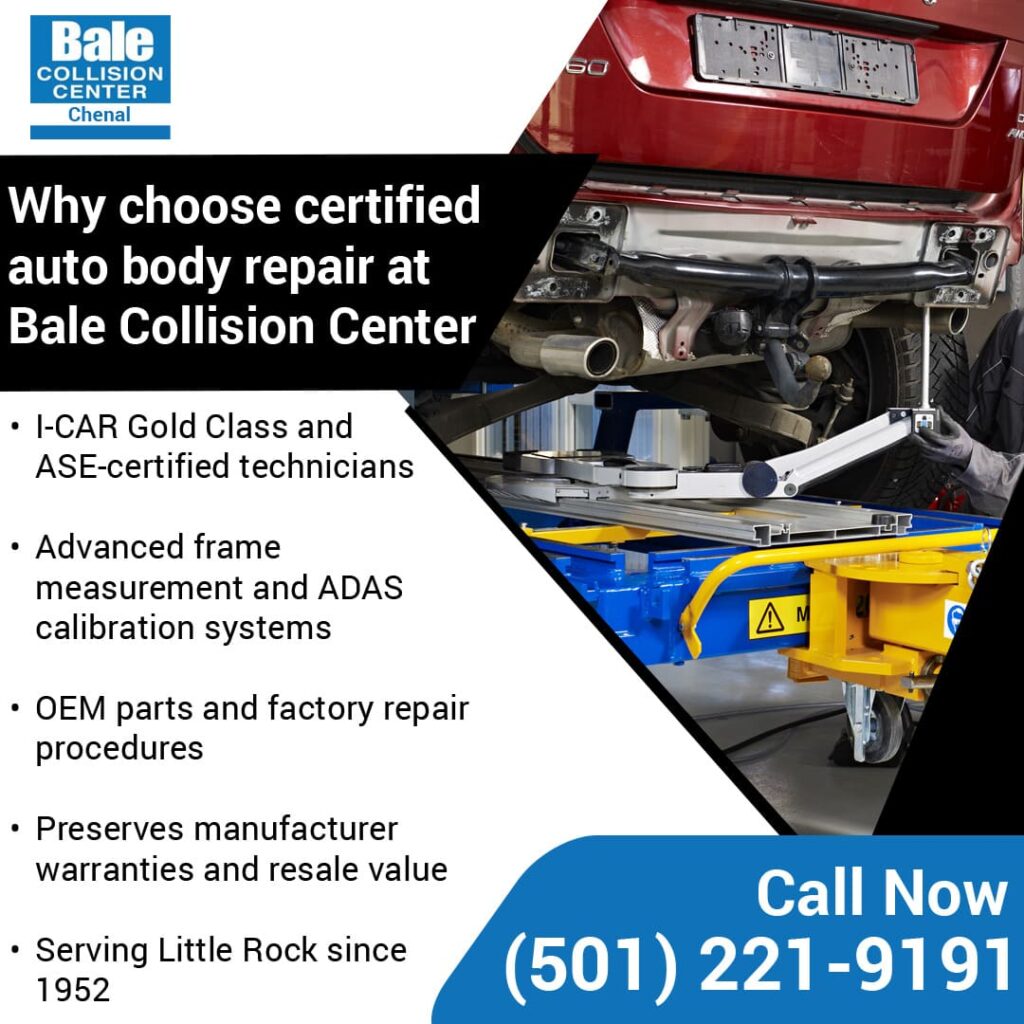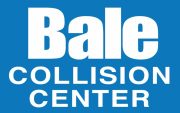Vehicle collisions create stress and uncertainty for drivers. Beyond the visible damage to your car, critical questions arise about where to seek repairs and whether the work will restore your vehicle’s safety and performance. The choice between a certified auto body shop and a non-certified facility carries consequences that extend far beyond initial repair costs.
Certified facilities maintain verified training standards and follow manufacturer-approved procedures. Non-certified shops operate without these requirements, often taking shortcuts that compromise structural integrity and safety system function. These differences directly affect your vehicle’s ability to protect occupants in future collisions, maintain manufacturer warranty coverage, and preserve resale value.
At Bale Collision Center (Chenal), our I-CAR and ASE certifications represent more than credentials on the wall. They demonstrate our commitment to proper auto body repair through continuous technician training, investment in specialized equipment, and adherence to manufacturer specifications. Since 1952, we have served the Little Rock community by combining proven expertise with modern repair technologies that today’s vehicles require.

What Certification Means
Certification proves that a shop meets specific industry standards for training, equipment, and procedures. Independent organizations verify these credentials through testing, audits, and ongoing requirements.
Three main certification types exist in collision repair. I-CAR certifications apply to both facilities and individual technicians. ASE certifications verify individual technician skills and knowledge. OEM certifications come directly from vehicle manufacturers who approve specific shops to repair their brands according to factory standards.
Vehicle technology advances rapidly. New materials like high-strength steel and aluminum require different repair techniques than older vehicles. Safety systems need precise calibration after auto body repairs. Certification programs keep repair shops current with these changes. Without certification requirements, shops can fall years behind in knowledge and capabilities.
Certified Shop Standards
I-CAR Gold Class Certification
I-CAR Gold Class represents the highest standard in collision repair. Only 10-20% of auto body shops nationwide hold this certification. The rarity reflects the substantial commitment required to achieve and maintain it. To earn Gold Class, shops must have trained technicians in four key roles. These specialists include:
- Damage estimators: Assess repair needs and create accurate cost projections.
- Structural technicians: Repair frames and safety cages.
- Non-structural technicians: Handle body panels and exterior components.
- Refinish technicians: Restore paint finishes to factory standards.
Each technician completes progressive training through three ProLevel stages that build from foundational knowledge to expert status. Annual continuing education maintains these credentials and introduces new repair methods as vehicle technology evolves.
ASE Certification
ASE (National Institute for Automotive Service Excellence) certifies individual technicians rather than entire shops. Technicians need two years of hands-on experience plus passing scores on rigorous exams. This combination validates their repair capabilities.
ASE tests cover painting and refinishing, non-structural damage repair, structural analysis, mechanical and electrical components, and damage estimation. Only two out of three people pass ASE exams on their first attempt. Certifications expire after five years, requiring technicians to retest and demonstrate continued competency.
OEM Manufacturer Certifications
Vehicle manufacturers certify specific auto body shops to repair their brands. Each manufacturer sets its own requirements for tools, training, and procedures. For example, Ford requires different equipment and training than Honda or Subaru.
OEM certification matters most for vehicles under manufacturer warranty, new vehicles with advanced technology, and luxury or electric vehicles. Certified shops receive direct access to manufacturer repair procedures, technical support, and approved parts that non-certified facilities cannot obtain.
Non-Certified Shop Realities
No Training Requirements
Non-certified shops operate without mandatory training standards. Owners determine whether or not their technicians receive training. No independent organization verifies their knowledge or skills.
Some non-certified technicians have substantial experience. Others learned through informal apprenticeships, where the quality varied based on their mentor’s knowledge. The shop provides no verification of actual capabilities or current knowledge of modern repair methods.
Limited Equipment Investment
Modern car body repair requires expensive equipment. Computerized frame measuring systems cost tens of thousands of dollars. ADAS calibration tools require constant software updates. Advanced paint-matching technology represents a substantial investment.
Non-certified shops often lack this equipment because the investment doesn’t align with their business model of competitive pricing. Without proper tools, technicians cannot complete repairs to factory specifications. They improvise with basic equipment or skip critical steps entirely.
Aftermarket Parts Usage
Non-certified facilities frequently use cheaper aftermarket or salvaged parts instead of OEM components. These parts may fit poorly, fail prematurely, or compromise safety. Aftermarket parts create multiple issues. Incorrect dimensions cause panel gaps that allow water intrusion and wind noise. Weaker materials reduce crash protection. Incompatible electronics trigger system errors and warning lights. Salvaged parts from accident-damaged vehicles carry unknown histories of previous damage or material fatigue.
Key Differences That Affect Your Vehicle
Structural Repairs
Certified shops use computerized measuring systems that verify frame dimensions match factory specifications within millimeters. Technicians access manufacturer repair procedures that specify exactly where to cut damaged sections and how to weld replacement pieces.
Non-certified shops may rely on visual assessment or basic tape measurements. Frame damage that looks straight might deviate from specifications by several millimeters, enough to affect handling and tire wear. Improper welding techniques weaken structural integrity. Using incorrect welding methods on high-strength steel actually softens the material and reduces its protective capabilities.
Safety System Calibration
Advanced Driver Assistance Systems (ADAS) in modern vehicles include automatic braking, lane departure warnings, and collision avoidance. These systems require precise calibration after any collision repair. Sensors and cameras must align to exact specifications, or the safety features will malfunction. Certified facilities use manufacturer-approved calibration equipment and procedures specific to each vehicle make and model.
Many non-certified shops lack ADAS calibration capabilities entirely. Vehicles leave with malfunctioning safety systems. For example, automatic braking may fail when needed, lane warnings trigger incorrectly, and forward collision alerts don’t activate at the proper distances.
Paint Quality
Certified shops use spectrophotometer technology that analyzes your vehicle’s exact color under multiple lighting conditions. Computer software formulates paint that matches original finishes precisely.
Non-certified facilities often mix paint by eye or use generic formulas. Color mismatches become visible in sunlight, where the repair looks different from the surrounding panels. Metallic finishes show different flake patterns. Clear coat application may be uneven or too thin, leading to premature failure.
Parts Quality
Certified auto body repair facilities use OEM parts whenever possible that meet the manufacturer’s crash testing standards. These components underwent extensive engineering and validation. Parts fit precisely with correct mounting points. Integration with vehicle systems works properly because electrical connections match original specifications.
Non-certified shops purchase cheaper alternatives to reduce costs. Aftermarket bumpers may not absorb impact correctly, compromising crash protection. Beyond physical issues, electronic components malfunction because software versions don’t match vehicle systems, causing warning lights to appear when incompatible parts confuse vehicle computers.
How Certification Protects You
Safety Protection
Proper car body repairs restore your vehicle’s ability to protect occupants in future collisions. Vehicle manufacturers engineer specific safety features into every model. Crumple zones absorb impact energy through controlled deformation. Airbag deployment timing depends on sensor data and structural response.
Certified shops follow procedures that maintain these critical safety features. Frame repairs restore proper crumple zone function. Sensor calibration maintains correct airbag deployment timing. Structural welding preserves seat belt anchor strength.
Non-certified repairs may look acceptable, but fail to provide proper crash protection. Insurance claims data show that improperly repaired vehicles suffer worse damage and higher injury rates in subsequent collisions.
Warranty Preservation
Vehicle manufacturers require repairs to follow their specifications. Using non-approved parts or procedures for auto body services can void warranty coverage. Manufacturer warranty agreements specifically state that repairs must meet their standards.
Certified shops document that repairs meet manufacturer requirements. Repair orders specify OEM parts usage. Calibration records show proper system restoration. This documentation protects you from warranty claim denials.
Resale Value
Buyers and dealerships check vehicle history reports before finalizing purchases. Repairs documented from certified facilities maintain higher resale values because buyers trust the quality. Non-certified repairs raise questions about hidden damage or shortcuts.
Professional vehicle inspectors can identify substandard repairs. Paint thickness measurements reveal excessive filler. Panel fit assessment shows alignment problems. Frame measurement verification detects structural misalignment. Poor repairs discovered during inspections reduce offers by thousands of dollars or prevent sales entirely.
Insurance Benefits
Many insurance companies prefer or require certified repairs. Some insurers offer lifetime guarantees on certified repairs that cover workmanship for as long as you own the vehicle. Rental car coverage extensions provide transportation during longer repair processes. Preferred claim handling streamlines the process and reduces customer service complaints.
Verifying Shop Credentials
Check Official Databases
Legitimate certifications can be verified through the organization’s websites. I-CAR maintains a public Gold Class shop locator searchable by zip code. ASE provides technician certification verification. OEM websites list approved repair facilities with search tools. Visit these sites and search for the shop name and location before making repair decisions. Current certifications appear with issue dates and expiration dates that confirm active status.
Inspect Shop Documentation
Certified auto body shops display current certificates in customer waiting areas. I-CAR Gold Class plaques show the current year and facility name. Individual technician ASE credentials list specific certification areas. OEM manufacturer approvals display logos for brands the shop is certified to repair. Ask to see documentation if certificates aren’t visible. Legitimate shops gladly provide verification and explain their certification status.
Ask Specific Questions
Asking detailed questions about certifications, equipment, and procedures helps verify whether a shop truly meets certified standards. Request details about which technicians hold which certifications. Ask what calibration equipment the shop owns and whether they calibrate in-house. Inquire whether they use OEM or aftermarket parts as standard practice. Confirm that they follow manufacturer repair procedures. Ask how they document completed repairs.
Vague answers or reluctance to provide details indicate potential problems. Certified car body repair shops answer these questions directly because their credentials verify the information.
Warning Signs
Several red flags suggest non-certified operations. Claims about quality without specific certifications rely on subjective statements. Pressure to accept quick estimates without a thorough damage assessment indicates shortcuts. Resistance to providing detailed repair plans suggests limited technical knowledge. Extremely low prices than certified competitors reflect reduced costs from cheaper parts and inferior equipment.
Why Choose Certified Auto Body Repair in Chenal, Little Rock, AR
Local conditions and driving patterns in the Chenal area make certified repair quality particularly important for vehicle owners. Understanding how regional factors affect your vehicle helps explain why choosing a certified facility protects your investment and safety.
Local Traffic Challenges
Chenal Parkway experiences heavy traffic throughout the day as a major commercial corridor. Highway 10 and Highway 430 bring additional collision risks from high-speed merging. When accidents happen, proper repairs matter for your safety and your family’s protection. Modern vehicles contain advanced safety systems as standard. These systems require certified expertise that non-certified shops cannot provide without proper training and equipment.
Long-Term Value
Arkansas vehicle owners keep their cars longer than the national average. Certified auto body repair in Chenal, Little Rock, AR, maintains vehicle reliability and value throughout extended ownership periods. Poor repairs create ongoing problems that reduce both safety and resale potential. The humid Arkansas climate accelerates corrosion of improperly repaired panels. Temperature fluctuations stress poorly calibrated systems. Highway driving conditions reveal handling problems from misaligned frames.

Trust Bale Collision Center for Certified Auto Body Services
Certification represents more than paperwork displayed on walls. These credentials verify training, equipment, and procedures that directly affect your vehicle’s safety and value. Non-certified shops lack accountability and often compromise quality to reduce costs without regard for long-term consequences.
At Bale Collision Center, we maintain I-CAR Gold Class certification with Platinum-certified technicians across all repair disciplines. Our ASE certifications demonstrate individual expertise in structural repair, non-structural work, refinishing, and damage estimation. We follow OEM procedures for every vehicle we repair. Our shop uses advanced equipment, including BASF paint systems, Car-o-liner frame technology, and VSSTA diagnostic tools, to deliver the quality auto body services that modern vehicles require.
Since 1952, we have served the Little Rock community with integrity spanning three generations. Our commitment to certified auto body services protects your investment and your family’s safety through proper procedures and verified credentials.
Experience the Certified Difference
Don’t risk your vehicle’s safety with non-certified repairs. Contact Bale Collision Center today at (501) 221-9191 for expert collision repair backed by verified credentials and proven results. Our team provides certified auto body repair in Chenal, Little Rock, AR, with I-CAR Gold Class technicians and modern equipment. Email bccwlr@baleautomotive.com or visit our Chenal location to learn more about our auto body repair services.
